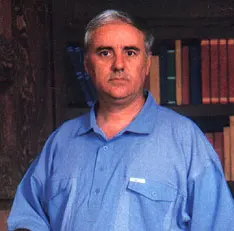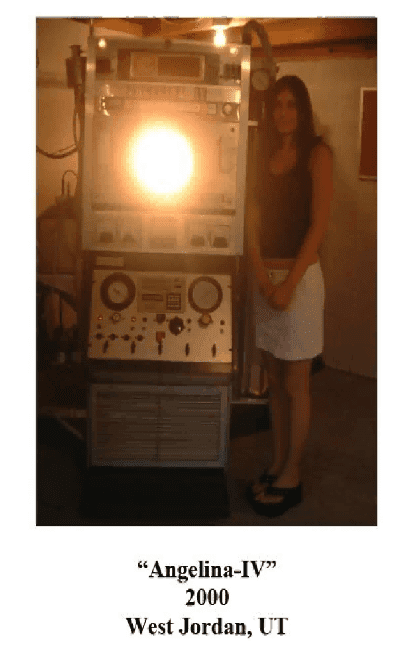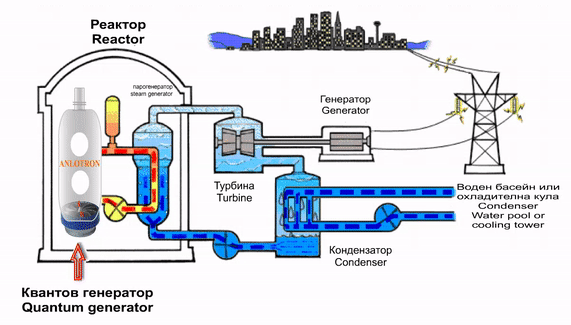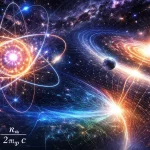Quantum Energy Generation System
- Written by dr. Chukanov
- on 04.12.2023


EFFICIENT TRANSFORMATION OF ELECTRICAL ENERGY INTO HEAT USING A QUANTUM PLASMA GENERATOR
Main advantages- 1. There is no environmental pollution from harmful gases and radiation emissions.
- 2. Inputting less energy to produce a gigacalorie or megawatt-hour unit of output.
- 3. Possibility of reconstruction of previously built hot water and steam facilities with Quantum heat sources and their further operation with improved energy efficiency, without harmful gas emissions.
Author:


Kiril Chukanov
Dr. Kirill Chukanov is an important scientific author in the field of quantum science, with a specialization in free energy from ball lightning.
Latest:


Angelina IV – Advancing Control and Containment
Newsletter
Subscribe to our newsletters with articles and receive special offers or the latest information.
Share Page:


When the geometry of the quartz chamber approaches a sphere – this peculiar electric ring gives the contours of our PLASMA-SPHERE. The field that repels the fast electrons is a powerful spherical electric field. Of course, under certain conditions it can be overcome:
- By electromagnetic means – e.g. with the pulses of suitable radar magnetrons;
- Electrically – through the introduction of powerful pulses from high-power capacitor batteries along the periphery of the sphere;
- By mechanical means – with the supply of jets of air with a certain intensity from the outside;
- By increasing the pressure in the working chamber, etc. In this way, contact with the high temperatures of the plasma is allowed, in which an air stream can be heated to various degrees and carry this temperature outside the quartz chamber.
In all cases, when there is an additional flow of air brought in from the outside to contact the high-temperature plasma, ADDITIONAL IONIZATION IN THE ABOVE MENTIONED PLASMA-SPHERE is reached. Let’s call this PLASMOSPHERE EXCITATION. We achieve arousal in several ways, which can also work together if necessary:
- By means of different pulses of radar magnetrons – denoted as R1 R2 R3.
- By means of electrical pulses supplied by a powerful capacitor battery.
- By means of a controlled air jet – directed to the core of the plasmasphere.
- By changing the pressure in the working chamber.
- By controlling the power of the various magnetrons, etc.
Bearing in mind the need to create an installation that will work in a continuous 24-hour mode, passing through different modes and states – we propose the creation of a Quantum Generator with a variable excitation algorithm and a PLASMO-SPHERE operating mode. Figure 1.1 shows a block diagram of the generator. The actual generator is located in the executive part. An important part of it are the magnetrons as executive elements, and we must immediately say that they are of 2 types: base magnetrons M1 M2 M3 – operating at a frequency of 2.45 GHz – they are 3 in number and are located in a circle through 120 degrees. And immediately next to them are 3 more excitation magnetrons, R1 R2 R3 – operating at a frequency of 9.4 GHz.


All processes are managed and controlled through a controller that is programmed from a control panel. The controller makes decisions based on information from a sensor unit that monitors a range of temperatures, pressures, voltages, currents, power, etc. and of course depending on the power set by the user. Naturally, the controller can be managed and monitored remotely through a standard network interface, it contains a memory for recording all events during operation. Direct control of the magnetrons is carried out by separate blocks. The circuit also includes an oxyhydrogen generator with the main function of switching current pulses from a capacitor block composed of special high-power capacitors. Finally, let’s also mention the air and vacuum control units in the working chamber. These blocks control a vacuum pump and compressor with the necessary parameters. Once the required power is claimed, the power generator must create a PLASMA SPHERE. For this purpose, it is necessary to carry out a rapid initial ionization of air in a previously constructed working chamber. This is what it should look like:


It is a massive cylindrical construction in the housing of which a cooling water jacket is built in (marked in blue). A special electric valve is built in the upper end, which closes when necessary to vacuum the microwave chamber – occupying the main volume of the generator. A central role is played by the quartz bell because in it the PLASMA SPHERE is created. A magnetron block is built into the upper part of the housing to create different conditions for ionization and impact on the air in the working volume. The magnetrons are controlled by the main controller, depending on the parameters of the air in the working volume. The creation of PLASMA is most easily done by temporarily evacuating the chamber using a vacuum pump. Then the air is drawn to the -875mBr state. The diagram of the generator is completed to the following figure: (the lower figure shows a top view – a horizontal section of the generator).
A vacuum pump is started, which expels the available air in the working chamber.
The air is drawn to a state of -875mBr. This is required only at lower powers of the pulsed radar magnetrons (below 10 kilowatts). With a higher power of the radar magnetrons – for example 30 kilowatts – the ignition of the process by vacuuming the chamber may be omitted, respectively the vacuum chamber and the outlet valve may not be installed at all. Simply, at normal pressure in the chamber, the three radar magnetrons are turned on, they start radiating simultaneously from three sides through 120 degrees at one point inside the quartz chamber, ionization immediately occurs and a small quantum object is formed, which expands to working size after turning on the the basic magnetrons.
Starting the R 9.4GHz magnetrons – let’s call them: excitation magnetrons – directs for a few seconds electromagnetic focused waves to the center of the quartz chamber at the top and end, and immediately from the ionization a miniature plasma is ignited. At this point, the base magnetrons M2.45GHz are switched on, which rapidly expand the ionization in the volume of the quartz bell. This is followed by an immediate de-vacuum through the simultaneous action of an additional compressor and the opening of the special electric valve in the upper part. Air enters the working chamber, and the plasma in the quartz bell turns into a PLASMA SPHERE.
A little further clarification is needed here. This creates a very rapid equilibrium between the wave energy of the base magnetrons M1 M2 M3 and the PLASMA SPHERE, which is a natural resonator for the incoming microwaves. M1M2M3 magnetrons, among other things, are powered by a special path – frequency and phase dependent. In the general case, a standard three-phase mains supply (with a frequency of 50-60Hz) can be used and each of them is powered by a separate phase, i.e. dephased by 120 degrees. And since the M1M2M3 magnetrons themselves are located at 120 degrees in space, the field they create rotates in time with the supplied frequency, for example 50Hz. In fact, a special converter power unit controlled by the central controller will change the frequency depending on the required friction between the outer layers of the PLASMA SPHERE and the quartz chamber. This creates the following extremely important working conditions:
- A denser and more homogeneous microwave electromagnetic field
- More efficient use of electron energy from the outer layer of the PLASMA SPHERE
- Better temperature balance of the work process, etc.
This is followed by an immediate de-vacuum through the simultaneous action of an additional compressor and the opening of the special electric valve in the upper part. Air enters the working chamber, and the plasma in the quartz bell turns into a PLASMA SPHERE. the process etc.
The plasmasphere quickly gains temperature in its central part – the lightning core – it reaches its optimal version under the created conditions, reaches a quantum boundary steady state – approximately 5000-6000 degrees and strives to keep it. The so-called constant quantum temperature of the two-dimensional quantum nucleus is reached. From the fluctuation of the electrons in the boundary regions and their subsequent spontaneous return to the equilibrium state – energy is released in the form of photons, and when measuring the input and output energy of the generator, in almost all cases, OVER UNITY 1.38 TO 1.40 is reached. In this state, the plasmasphere is in an unexcited state and does not generate free quantum energy.
In this state, the PLASMA SPHERE becomes hotter and hotter as the free electrons in the outermost layer of the lightning strike the air particles and begin an exchange of energy in the form of heat. In some isolated cases some quantum electrons also come into play and they give 100% of their energy to the air.
It is necessary to bring the PLASMA SPHERE into the mode of additional excitation, which will drag additional quantum electrons into the events. This can be done in several ways, happening individually or together. We will focus on the 3 most important of them:
1. By attacking the PLASMA SPHERE with a series of radar magnetron pulses in one central area (dynamically changing the contact between pulsed magnetron waves and the PLASMA SPHERE core is possible) with the R9.4 GHz magnetrons
It is quite clearly visible when viewed from above. The plasmosphere (ball lightning) is a huge atom composed of a two-dimensional positively charged core – which is surrounded by three-dimensional electron layers of electron shells. Radar pulses electromagnetically penetrate these layers and this is accompanied by a giant macroatomic radiation of photons and heat, during which additional energy is released and the so-called OVER UNITY can increase more than 10 times – the exact value depends on the preset powers of the various species magnetrons, the dimensions of the working chamber, etc.
2. Without stopping the previous excitation, we can introduce additional electrons from the outside into the process by supplying powerful electrical pulses from a pre-charged capacitor bank. Practice has shown that if 2 tungsten electrodes, for example, are introduced to touch the PLASMA SPHERE – a large electrical impulse with parameters specific to the technology can be sent through them. The electrical excitation is a fact, but the PLASMA SPHERE quickly wears out the tungsten electrodes and the process stops. Therefore, here we apply gas electrodes using the well-known oxyhydrogen gas. Thus, the electrical impulse passes through the self-igniting gas – supplied under pressure at the required speed and the gas itself becomes a commutator.
The electrical pulse attracts many additional quantum electrons and a powerful eruption of the PLASMSPHERE is reached, which makes a qualitative big jump in the heat exchange with the air passing through the working chamber at normal pressure of the working environment. And to top it all off, we come to one more possibility – INCREASE THE PRESSURE IN THE CHAMBER
3. When increasing the pressure within reasonable limits (by reasonable we mean those limits of pressure change – within which the PLASMA SPHERE will not go out and the processes will stop or the temperatures resting on the walls of the quartz chamber will not exceed 1560 C˚ , where the quartz starts to soften and melt) – for example up to 8 atmospheres. These atmospheres are achieved with a simple compressor tailored to the required air flow. The special thing is that we direct a strong air jet into the center of the quartz chamber. This further agitates all levels of the PLASMA SPHERE and forces numerous air particles to touch the hot central part of the sphere. Air jets in the chamber, their direction and parameters in general strongly influence the operating modes.
The outgoing air flow carries the thermal energy in the direction we decide – for example, to the inlet of a water heating boiler, or to the respective turbines of a power plant, etc. This is clearly shown in the diagrams below. We will only add that we can put the warm air in the bypass and at the outlet, e.g. of the water boiler, the outgoing air has not yet managed to cool down – it is fed back into the quantum generator and is only heated up further. All this is possible simply because the air along the entire tract remains practically unpolluted (a fact of enormous ecological importance).
Gas turbine power plant with quantum generator


The gas power plant receives its input heat from gas burners – burning natural gas. Naturally, it is not a problem to obtain the input heat from a heated air stream obtained from a Quantum heat generator.
Quantum generator for hot water boiler


Regardless of the burners of a given standard boiler – oil or gas, they can be replaced by quantum heat generators.
Replacing the nuclear reactor of the NPP with a quantum generator


Nuclear power plants can be powered by powerful quantum generators. Radioactive elements will be removed and only the first circuit will be preserved, the heat of which will be provided by hot air obtained from contact with ball lightning. The existing steam generator will be preserved, as well as everything to the end three-phase generator for electricity. Thus, all Kozloduy reactors, stopped for political reasons, can be started again.






